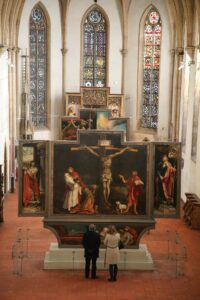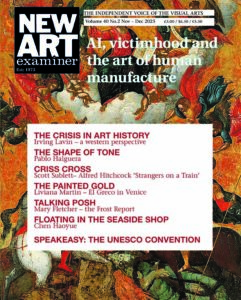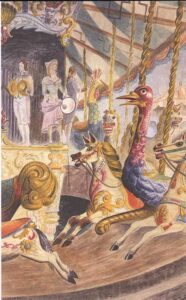
Isenheim Altarpiece, Nikolaus Hagenauer and Matthias Grünewald, c 1512–1516
German Painter Matthias Grünewald (1470-1528) is one of the most amazing German Renaissance painters. He is very studious and well-informed and always shows compassion for others. At the rise of the Reformation Movement people were deeply dissatisfied with the poverty of their lives and the restraint of religion. He was concerned about the people and defended the new trend of thought. He was dismissed as the court painter because of his sympathy for the Reformation Movement.

Grünewald is a master of the late Gothic Art, inheriting the ingenious use of light and color from Gothic art. The style of his painting is full of dramatic tension; the depiction of death and pain, fantasy and morbidity is the tone of his works. He shows his real talent with his altar paintings; the Isenheim Altarpiece (c.1512-1515), a hospital church painting in the monastery of St. Anthony in Isenheim, is the masterpiece of his altarpieces. It is also one of the most dynamic works of Christian art.
Unlike other painters who use “tranquility” and “honor” as the main theme of the hospital church, “The Crucifixion” in the center of the “Issenheim Altarpiece”; it highlights pain and suffering. Combining medieval mysticism with Renaissance techniques, Grünewald recreated the scene that completely struck the viewer. He is not very interested in the beauty of humanity or the environment. He unveiled the cruel reality of suffering, leading the viewer into a horrible, soul-faced, tragic new field; it seemed to release the devil. The painting was completed in 1517, the year of the German Reformation Movement. The violence and ugliness in the painting seem to predict the division of the church at that time and to untie its bond through reformation.
When we stare at the details of the painting, we see Christ’s body torn open and nailed to the cross, which creates an intense atmosphere. Even the wood was pressed and bent down, for He assumed the sins of the whole world. His fingers appear distorted and stretched due to the severe pain, almost breaking through the frame. Each twitching finger told of the sorrow. The crown of thorns on his head was unbearable, and his body was covered with thorn wounds; his feet were deformed and twitched, as the blood dribbled from his toes. The last word of Christ were “It is finished.” (John 19:30) It is as if it is still echoing in the painting; after that, He bows his head and gives his soul to God.
Compared to the tall figure of Christ in the painting, the slightly thin Mary Magdalene, dressed in worldly clothes, bends to the side with inner sadness and despair. Her hands that stretch out to the cross exposed her anguish and her body, which seemed to be grieving and swaying back and forth. The mother of Jesus on the left side was wearing a white robe. She seemed to have lost consciousness and fell into the arms of the disciple John with her heart broken by misery. John the Baptist, who had already been beheaded, should not appear according to the timing. Gruenwald’s arrangement of his appearance, however, broke the constraints of time and, in doing so, added a sense of timelessness to the suffering. John the Baptist’s “calm” face also slightly dilutes a cruel sense of oppression; written in his side in Latin (“pointing out”) “He must become greater; I must become less.” (illum oportet crescere me autem minui) (John 3:30).
This painting gives patients in the hospital church the encouragement and confidence to fight disease and helps them feel the presence of God’s grace. Perhaps Grünewald wants to help fatally ill patients understand that pain is also part of God’s plan; this is a war between God and the invisible dark powers, and the enemy only temporarily took power in this world and won the victory on the cross. Or, Grünewald believes that those unfortunate patients who suffer from physical and mental burdens can fully understand that this ugly presentation is more real than the idealized (beautified) suffering.
Dr. Sheng-Yu (David) Peng, PhD in Theology of Edinburgh University, Scotland
Director, Centre for Academic Development of Taiwan Baptist Christian Seminary
德國文藝復興畫家 – 格呂內瓦爾德: 殘酷背後的救贖 (Matthias Grünewald, 1470-1528)
彭盛有
英國愛丁堡大學哲學博士
基督教台灣浸會神學院教授
德國海德堡大學訪問學者
德國畫家馬蒂亞斯.格呂內瓦爾德(Matthias Grünewald, 1470-1528),是德國文藝復興畫家中令人驚歎的一位。他博學多聞,對人常存惻隱之心。宗教改革運動興起之際,人民由於生活貧困,對宗教的箝制也深表不滿,他關切人民,捍衛新思潮。因著對宗教改革運動的同情立場,他被解除了宮廷畫家的職務。
格呂內瓦爾德是晚期哥德藝術(Gothic Art)的大師,承傳了哥德藝術對光和顏色的巧妙運用。他的畫風充滿了強烈的戲劇張力,死亡與苦痛、幻想與病態的描繪是其創作的基調。他尤其擅長祭壇畫,為伊森海姆市(Isenheim)聖安東尼修會修道院附設醫院教堂畫的《伊森海姆祭壇畫》(Isenheim Altarpiece, c.1512-1515)正是其祭壇畫的傑作,亦是基督教藝術中最富感動力的作品之一。
有別於別的畫家以「寧靜」或「尊貴」作為醫院教堂的創作主調,《伊森海姆祭壇畫》中央的「基督十架受難」(The Crucifixion)突顯了痛苦和苦難的可怕。結合中世紀的神秘主義與文藝復興時期的技藝,格呂內瓦爾德重現了那徹底撞擊觀者心靈的景象。他對人類或環境之美不怎麼感興趣,他赤裸裸地描述了受難的殘酷現實。他將觀者領入一個令人毛骨悚然的、心靈面的、悲慘的新領域;彷彿釋出了魔鬼。這幅畫完成於德國改教運動的一五一七年,畫中呈現的暴力和醜惡,似乎預言了當時教會的分裂,通過改革來解除束縛。
當我們凝視畫中的細節時,基督的身體被拉開釘在木頭上,每一根神經都是緊繃的;甚至連木頭都被重壓而下彎,因祂承擔了整個世界的罪惡。祂的手指因劇痛而竭力扭曲外伸,幾乎要衝破畫框,每一根痙攣的手指都在傾訴著悲苦。頭上的荊棘冠冕是難忍的,渾身也佈滿了荊棘傷口;祂的雙腳被抽打變了形,抽搐般地交疊著,鮮血從趾縫間緩緩滴淌。基督的末語「成了」(約十九30)彷彿仍在畫中迴盪著;之後,祂就低下頭,將靈魂交給上帝。
相較於畫中基督身形的高大,略顯瘦小的抹大拉的瑪利亞,穿著世俗衣裳屈身旁跪,內心的哀傷和絕望,透過伸向十架的那手指交纏著的雙手表露無遺,她的身體似乎傷心而前後搖擺著。耶穌的母親在左側身穿白袍,她看來已失去了意識,神情恍惚地倒在門徒約翰充滿情感的手臂裡,悲痛絞碎了她的心。早已被砍頭的施洗約翰,按照時序是不該出現的,而格呂內瓦爾德安排他的出現卻解消了時間的制約,為受難事件添增了永恆感。施洗約翰的「冷靜」面容,也稍微沖淡一點殘酷的壓迫感;在他的身旁以拉丁文寫著(「指」出)「祂必興旺,我必衰微(illum oportet crescere me autem minui)。」(約三30)。
這幅畫對醫院教堂中的病患提供了抵抗疾病的鼓舞與信心,使他們感到上帝恩典的臨在。也許格呂內瓦爾德想幫助絕症患者明白,痛苦也是上帝計劃的一部分;這是上帝和看不見的黑暗勢力的戰爭,仇敵只是暫時在此世掌權,贏得了十字架上的勝利。或者,格呂內瓦爾德認為,那些承受著身心重擔的可憐患者完全可以明白,這種醜惡的呈現要比理想化(美化)的受苦更加真實。
Dr. Sheng-Yu (David) Peng, PhD in Theology of Edinburgh University, Scotland
Director, Centre for Academic Development of Taiwan Baptist Christian Seminary


…both Grunewald and the author Sheng-Yu have taken a wise path in regard to the fine (but hard) relevance of *reality* even in the face of suffering and painful deaths – plus, in a hospital setting where one expects to find the “tranquility” and “honor” twists that undercut that Real. I must add however that I disagree with some aspects of his review. I think Grunewald was very well-acquainted with the human form and material presentations that helped ‘glorify’ those forms and the touch of ‘nature’ depicted in the little sheep that actually does offer ‘tranquility’ to the scene: the only sure sign of observance, compassion, love. Furthermore, Grunewald’s display of Landscape is in full observance in all depictions, especially the predella (at kneeling height) that furnishes all the horizontal aspects we need to suffice (importantly, as ground – or resting, burial space).
This is a very observing article, thanks for Peng’s writing.
谢谢NAE提供中英双语的艺评,我身旁有很多热爱艺术但以中文为主要使用语言的朋友。我认为这样的文章对他们(包括我自己)有很大的帮助。
Thank you NAE for providing Chinese and English bilingual art reviews. I have many friends who love art but use Chinese as their main language. I think such an article is very helpful to them (including myself). (Translated by the New Art Examiner)
Thank you, Dr. Sheng-Yu Peng, for a look at the psychology of art. In Egypt, one cure for illness was to have the priest read from the sacred books to the patient, telling how the Gods themselves suffered the same illness, thus giving the patient a psychological boost that they weren’t alone. The same process is pointed out by Dr. Peng in this article. The mind has strange healing powers and morale is very much a part of it.